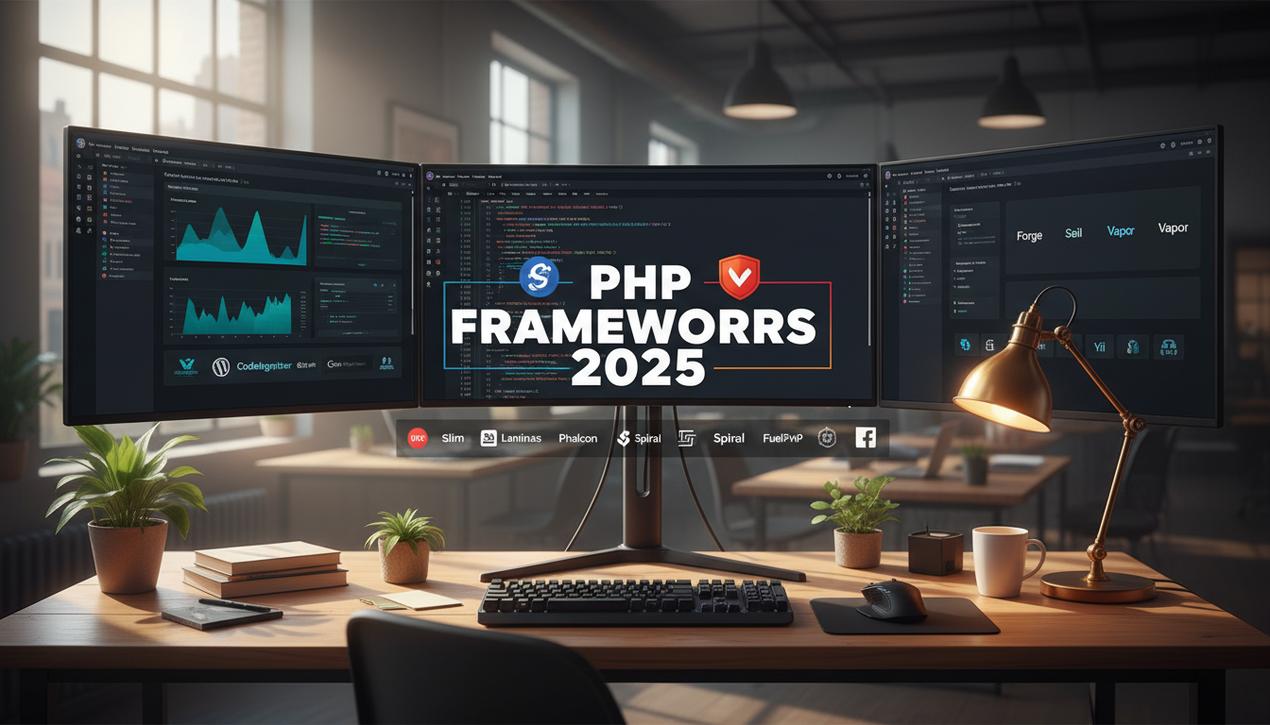Top Front-End Frameworks of 2025: The Ultimate Guide


In the ever-evolving ecosystem of web development, choosing the right front-end framework is more critical than ever. In 2025, the landscape is dominated by established giants while being disrupted by innovative newcomers. Recent statistics show that while React maintains its leadership position, used by over 40% of developers, frameworks like Svelte boast satisfaction ratings above 70%. This dynamic highlights a clear trend: performance, developer experience, and the ability to build fast, accessible interfaces are the deciding factors. Navigating this sea of options can seem complex, but using essential wireframe tools and understanding the strengths of each framework is the first step to ensuring technical success. This article explores the essential frameworks, the rising stars, and the specialized tools to help you make an informed choice for your web creations in 2025.
The Undisputed Market Leaders
Three frameworks continue to dominate the market. Their maturity, vast ecosystems, and active communities make them safe and powerful choices for a wide range of web projects, from enterprise applications to large-scale interactive platforms.
1. React
Developed by Meta (formerly Facebook), React is technically a library for building user interfaces, not a strict framework. Its popularity is immense, making it the most used front-end tool globally. Its component-based architecture allows for the creation of complex, reusable UIs. React’s greatest strength is its ecosystem, with tools like the Next.js meta-framework transforming it into a full-stack powerhouse optimized for server-side rendering (SSR) and static site generation (SSG).
2. Angular
Backed by Google, Angular is a comprehensive, opinionated framework built on TypeScript. It provides a robust structure for developing complex and scalable enterprise applications. Although its learning curve is steeper than its competitors, it offers an all-in-one solution that includes routing, state management, and HTTP client modules out of the box. It is prized for its consistency, which guarantees a solid architecture for long-term projects.
3. Vue.js
Vue.js is often seen as the perfect middle ground between React’s flexibility and Angular’s structure. Created by Evan You, it is known for its simplicity and gentle learning curve. Vue is a progressive framework, meaning you can adopt it for a small part of an existing project or use it to build a full-scale single-page application (SPA). Its ecosystem, especially with the Nuxt.js meta-framework, is mature and enables the development of high-performance, well-structured applications.
The New Wave of High-Performance Frameworks
Alongside the leaders, a new generation of frameworks is rapidly gaining traction. Their common denominator is an obsession with performance, achieved by minimizing the amount of JavaScript sent to the browser and leveraging innovative compilation techniques.
4. Svelte
Svelte changes the paradigm. Instead of running its code in the browser, Svelte is a compiler that transforms your components into highly optimized, vanilla JavaScript at build time. The result is faster applications with less code. Its simple and elegant syntax has earned it the highest satisfaction ratings among developers in recent years.
5. SolidJS
SolidJS, or Solid, is a declarative, reactive library for building user interfaces. It draws inspiration from React but completely eliminates the Virtual DOM in favor of fine-grained reactive “signals.” This approach allows it to achieve near-native performance levels, making it one of the fastest frameworks on the market for DOM manipulation.
6. Qwik
Qwik focuses on a critical bottleneck: initial load time. It introduces a concept called “resumability,” which allows for the delivery of instantly interactive HTML pages without the need to download and execute large amounts of JavaScript. Code is only downloaded and executed when a user interacts with a specific component.
7. Astro
Astro is not a traditional JavaScript framework but rather a multi-framework site builder. It’s designed for content-rich websites like blogs, e-commerce sites, and portfolios. Its philosophy is “islands architecture”: it renders pages to HTML on the server and only loads JavaScript for the interactive components that need it, drastically reducing page weight.
CSS Frameworks: The Battle of Components vs. Utilities
Choosing a CSS framework is as important as selecting a JavaScript one. The underlying trend is a major shift from component-based libraries to “utility-first” frameworks that offer greater flexibility and customizability.
8. Bootstrap
The veteran and the benchmark. Bootstrap is a CSS framework providing a vast collection of pre-styled components (buttons, forms, modals). It is ideal for rapid prototyping and for developers who aren’t design experts. Its responsive grid system is powerful and easy to use.
9. Tailwind CSS
Tailwind CSS has revolutionized how developers write CSS. Instead of pre-built components, it provides low-level utility classes that allow you to build completely custom designs directly in your HTML. Paired with the best CSS generators for web design, this approach promotes design system consistency. Its popularity has exploded, making it a standard for many modern projects.
10. Materialize
Inspired by Google’s Material Design, Materialize offers a set of responsive components that follow these design guidelines. It’s an excellent alternative to Bootstrap for those seeking a modern and cohesive aesthetic out of the box.
Over 25 More Frameworks to Explore for Your Projects
Beyond the most famous names, many other tools deserve attention depending on your project’s specific needs. Here is an expanded list to cover every use case.
- Semantic UI: Shines with its simplicity and human-friendly HTML syntax.
- Foundation: An advanced and flexible framework, ideal for large-scale, professional websites.
- Skeleton: A true lightweight with only about 400 lines of code, perfect for small projects.
- PureCSS: Developed by Yahoo!, a set of tiny, responsive CSS modules.
- UIkit: A modular framework known for creating complex and powerful user interfaces.
- KNACSS: A minimalist French framework that is powerful but requires a solid CSS foundation.
- Milligram: Another minimalist CSS framework designed for a fast and clean starting point.
- Alpine.js: Describes itself as “Tailwind for JavaScript,” perfect for adding light interactivity.
- Lit: A simple and lightweight library from Google for building fast web components.
- Ember.js: A robust and opinionated JavaScript framework designed for productivity and ambitious web applications.
- Backbone.js: Lightweight and flexible, excellent for simple single-page applications.
- MontageJS: Specializes in building rich, single-page applications.
- Topcoat: Created by Adobe with a focus on performance for building fast web apps.
- KickStart: A lightweight and functional kit with everything needed to create a site in record time.
- Kube: A professional framework for developers who prefer not to use JavaScript.
- GroundworkCSS: Features a particularly advanced and flexible grid system.
- Cascade Framework: Offers developers more control than Bootstrap and adapts to older browsers.
- Jeet: Provides an advanced grid system to help you build faster with less code.
- Susy: An “on-demand” grid generator for building complex and custom layouts.
- Metro 4: Inspired by the Windows 8 interface, this framework is simple and customizable.
- Ink: A toolkit designed for faster and simpler development of user interfaces.
- Symfony: A full-stack PHP framework, but its “UX” component allows for creating rich interfaces.
- Django: The full-stack Python framework. While backend-focused, it’s often used to serve dynamic front-ends.
- Pyramid: Another popular and highly flexible Python framework.
- Yii Framework: A PHP framework known for its robust security features.
- CodeIgniter: A lightweight and fast PHP framework known for its simplicity.
- Fat-Free Framework: A quick and easy-to-use PHP micro-framework.
Key Trends Redefining Front-End Development
In 2025, several major trends are influencing the choice and use of frameworks. Ignoring them means risking technical debt.
The Rise of Meta-Frameworks
Tools like Next.js (for React), Nuxt (for Vue), and SvelteKit (for Svelte) have become essential. They add crucial features to the core libraries, such as file-based routing, server-side rendering, and performance optimization, dramatically simplifying the development of complex applications.
The Standardization of TypeScript
TypeScript has become the de facto standard for medium to large-scale JavaScript projects. Its ability to add types to code reduces bugs and improves maintainability. Most modern frameworks, including Angular, Solid, and Qwik, adopt it natively.
Accessibility Is No Longer Optional
Compliance with accessibility standards (WCAG) is now a legal requirement in many jurisdictions and a core tenet of inclusive design. Modern frameworks increasingly integrate tools and best practices to help developers build websites usable by everyone, including people with disabilities.
AI-Powered Development
Artificial intelligence, through tools like GitHub Copilot, is becoming deeply integrated into code editors. It helps write code faster, generate tests, and even optimize components. Modern frameworks are designed to work seamlessly with these AI assistants.
The world of front-end frameworks is more dynamic than ever. While leaders like React, Angular, and Vue remain dependable choices, newcomers like Svelte, Solid, and Qwik offer performance gains and developer experiences that are redefining industry standards. The final choice will always depend on your project’s constraints: the complexity of the UI, performance requirements, your team’s skills, and the long-term vision. The best approach is to stay curious, experiment with these new tools on personal projects, and choose technology not based on hype, but on its ability to solve your specific problems. By keeping an eye on foundational trends like AI and accessibility, you will be well-equipped to build the web applications of tomorrow and even explore this guide to mobile app languages.




